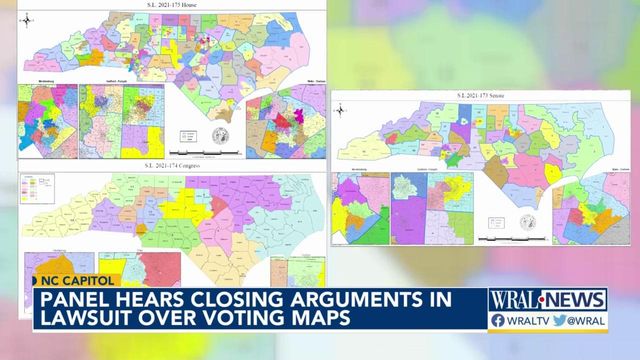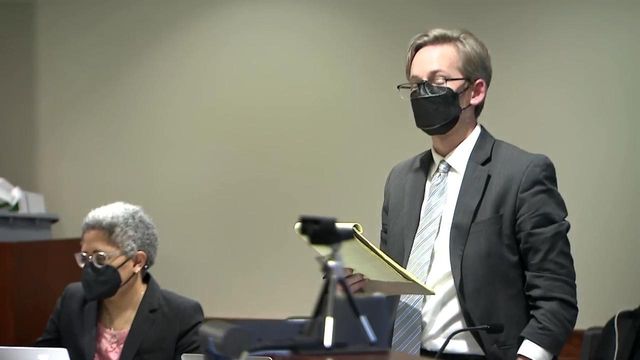NC redistricting trial wraps, ruling on legality of voting maps comes by Tuesday
Judges assigned to the case have until Tuesday to decide. The case will likely next go to the state Supreme Court.
Posted — UpdatedA whirlwind trial over North Carolina’s new election maps closed Thursday with challengers repeatedly calling the maps “extreme partisan gerrymanders” drawn by Republicans to skew elections in their favor.
In closing arguments Thursday, the lead attorney for GOP lawmakers called the case a hyperbolic ruse, brought by progressive groups that simply want more Democrats elected.
If upheld, a lawyer for the plaintiffs countered, the maps would render the elections in the state mere formalities because politicians have picked their voters by drawing precise lines to determine state congressional and legislative districts.
The case, which could decide political power in the state for close to a decade, is now in the hands of the state-appointed, three-judge panel that heard the trial in Wake County Superior Court. Their decision on whether the maps are constitutional is due by Tuesday.
The trial began Monday, stemming from lawsuits by voting rights groups and other plaintiffs who allege that election maps created and approved last year by the state legislature’s Republican majority are so biased toward the GOP that they violate the right to a free and fair election.
Republican defendants have maintained that they complied with map-drawing guidelines.
GOP lawyer Phil Strach asked the court to reject evidence from “the veritable Justice League” of mathematical and political experts brought in by the plaintiffs.
Strach called the simulations a “shiny irrelevant object” produced by computer algorithms that were written to make Republican maps look bad.
“I think about the Wizard of Oz,” Strach said. “When you approached the wizard he was grand … and then what you learned was that the Wizard of Oz was nothing more than a man behind the curtain.”
But even a political expert brought by Republicans acknowledged on the stand this week that the maps as they stand are “pro-Republican,” Elizabeth Theodore, one of several lawyers pushing this case, reminded judges. His analysis so effectively bolstered the argument to throw out these maps that he “could have been an expert for the plaintiffs in this case,” she said.
Superior Court Judges Graham Shirley, Nathaniel Poovey and Dawn Layton – two Republicans and a Democrat – gave no indication of when they’ll rule. An appeal to any decision is expected, and it will likely go to the state Supreme Court, where Democrats hold a 4-3 majority.
Republicans petitioned the Supreme Court late Thursday, saying Justice Sam Ervin, a Democrat who is the only justice running for re-election this year, should recuse himself in the case.
"Decisions that he makes on redistricting may impact voter turnout or other factors of the general election," they wrote.
In the end, the case may turn not on the math or on accusations of subterfuge, which arose out of Hall’s testimony. Instead, it may come down to how much influence the state judiciary believes it should have over a map-making process. The law generally leaves the map-making to the North Carolina General Assembly. A different three-judge panel threw out legislative maps in 2019, finding a partisan gerrymander then, but that case wasn’t appealed to the state Supreme Court.
Strach, who has defended Republican maps and other elections laws for years in North Carolina, said redistricting is an inherently political process, and he told the judges Thursday the state can’t replace legislative prerogative with computer algorithms.
“That’s not Democracy,” he said. “It is, in fact, a threat to Democracy.”
Challengers said lawmakers certainly enact the maps, but it’s up to the courts to ensure those maps comply with the state constitution.
“It’s fundamentally unfair, and it violates the North Carolina constitution,” Theodore said.
‘No plausible deniability’
That case is a consolidation of several lawsuits brought by left-leaning groups, the NC League of Conservation Voters and Common Cause, as well as a handful of North Carolina voters represented by a team of lawyers including the Elias Law Group, which is among the Democratic Party’s lead elections law firms nationwide.
Their core argument is that there’s no way a fair process would have produced the maps Republican lawmakers came up with last year in the once-a-decade redraw that follows each U.S. Census. The congressional map lawmakers drew is expected to elect 10 Republicans and four Democrats, based on past election results, and potentially 11 Republicans because one of the districts is fairly competitive. The state House and Senate maps would almost certainly re-elect the current GOP majorities and might bring back supermajorities in the two chambers. Such a scenario would enable the party to overturn vetoes by Democratic Gov. Roy Cooper. The plaintiffs used computer algorithms, written by multiple mathematicians and political scientists, to illustrate this. Time and again those algorithms produced maps likely to elect fewer Republicans than the maps lawmakers drew.
Lawyers for the Republican leadership didn’t even put on evidence this week to dispute the allegation that the new congressional map was built to elect Republicans by packing Democratic voters in Wake and Mecklenburg counties into districts and splitting Democrats in Guilford County across three districts that would almost certainly elect Republicans.
“There is no plausible deniability that this congressional plan is an extreme partisan gerrymander,” Theodore said during Thursday’s closing arguments.
‘Marginal differences’
The Republican defense countered that, ultimately, it’s not an advantage of very many seats. Simulations from one of the plaintiff’s own experts, University of Michigan professor Jowei Chen, drew a map electing nine Republicans 74 percent of the time. Ten percent of Chen’s simulations would likely elect 10 Republicans.
“Marginal differences,” Strach said, even if one were to buy what he described as the “rigged” math of various computer simulations, Strach said.
Strach also argued that algorithms used against Republicans fail to account for all the rules lawmakers had to adhere to during their redraw. He and other Republicans have said the GOP has a natural advantage in legislative and congressional districts because Democrats primarily live in North Carolina’s urban areas, whereas Republicans are more spread out.
Mathematicians on the stand this week stood by their algorithms and said the tilt in Republican maps can’t be explained by the self-sorting of voters. They also testified that it’s not just the number of districts that show a gerrymander, it’s the lack of competitiveness in those districts. Not only did Republicans draw maps to elect more Republicans, they drew maps where the GOP-leaning seats were safer for Republicans than a fair process would have achieved, experts for the plaintiffs testified.
Republican lawmakers repeatedly said they didn’t use partisan data, including election histories, or racial data to draw these districts. Legal teams for the plaintiffs scoffed at the idea, given that some of the districts they came up with were more favorable than 99.99 percent of districts drawn by one of the simulation algorithms. They also pointed Thursday back to Hall’s Wednesday admission that he relied on secret maps to draw parts of the state House map.
“Any court would find intentional discrimination,” she said in her closing argument.
• Credits
Copyright 2024 by Capitol Broadcasting Company. All rights reserved. This material may not be published, broadcast, rewritten or redistributed.






